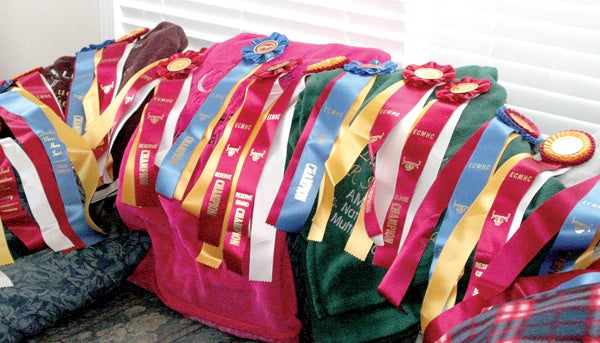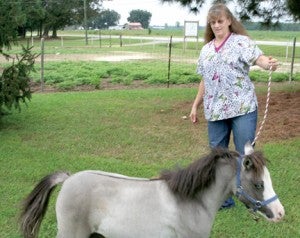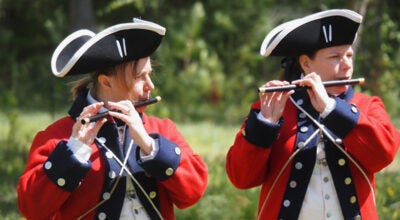Tiny trotters
Published 7:37 pm Wednesday, October 1, 2014

Since 2002, Dr. Cheryl Powell and husband David have entered their miniature horses in shows throughout the United States and by the look of the number of winning ribbons shown here, their entries have fared extremely well. Staff Photo by Gene Motley
POWELLSVILLE – They’re horses the size of a large dog, small enough – and some say cute enough – to carry in your arms when they’re young. They could also be saddled for riding, but best if that’s only done by children under 60 pounds, who can also look these horses right in the eye.
Small wonder so many people fall in love with them.
They’re miniature horses and they exploded in popularity in the 1970’s as more people wanted to breed them along with riding and show horses.
One such miniature horse lover – and showman – is Powellsville veterinarian Dr. Cheryl Powell, who doesn’t just raise miniatures, she raises champions.

Powellsville veterinarian Dr. Cheryl Powell works with “LTS Loose Change”, nicknamed “Nickel”, a four-year-old 33-and-a-half inch miniature horse she raised and who won Reserve National Champion at the recent AMHR Nationals in Oklahoma. Staff Photo by Gene Motley
“You spend time with them, raise them, keep them up on their shots, handle them every day and work them,” Powell says, smiling. “Just like any other horse.”
A mini must be no taller than 34 inches, measured at the top of its shoulders, where its mane ends. A full-grown mini weighs between 150 and 250 pounds. Although some minis resemble ponies, the goal of miniature horse breeders is to create a tiny horse, with everything about it the same as a full-sized horse, only smaller. Powell even refers to minis as “man-made”.
“They took a sturdy little Shetland pony and bred it down to look like a true miniature horse and not a pony,” Powell says. “When you take a picture they look just like an Arabian, or a thoroughbred, or quarter-horse with no size reference; and that’s what they breed them for now, so you don’t see a pony but instead you see a horse. When you look at (these animals) now they want you to see a horse.”
A veteran of local horse shows, and with her own horse farm, Lucky Trail Farms, located at her home, Powell had rescued some minis from years before and thus began a family affair.
“One day my daughter, Heather, was watching TV and saw a special on AMHA (American Miniature Horse Association) Nationals and so she came in and asked why we couldn’t show the minis,” Powell explained. “So we went in August of 2002 to our first show and we came home with two or three world champions.”
Even though the first miniatures came to the U.S. in the early 1800’s, they weren’t recognized as a registry until a century later, and only specific breeds.
“AMHA only recognizes horses 34 inches and under,” she continued. “AMHR (American Miniature Horse Registry) also recognizes (that size), but they also have a division for the 34-to-38 inch horse.”
In the dozen or so years since their first showing, Powell – along with her husband, David – have carried dozens of horses west to the Tulsa State Fairgrounds in Oklahoma to compete in the AMHR Nationals. The payoff has been 31 first-place finishes, six second places, and over 40 top-tens. Most recently the Powell’s took nearly 20 horses to the AMHR 2014 competition and returned with more ribbons and citations. They also returned home with more miniatures than they had when they left Bertie County.
In the Roanoke-Chowan area, there’s a big miniature horse show in Martin County at Williamston’s Bob Martin Ag Center in April and in June, but the Powell’s travel to shows all along the East Coast.
“We go to the area shows in either Delaware or Virginia,” Powell says. “We’ve also been as far as Atlanta and Illinois showing them before the Nationals in Tulsa which feature 381 classes of miniatures. When you place in the top (at Nationals), you actually get money back which is kind of nice.”
Because miniature horses can pull carts and buggies, driving classes are popular at shows where the most important thing is the performance of the animal and how well the vehicle, horse, and driver work and look together.
There are two kinds of events in which horses jump over fences: regular jumping classes and hunter classes. Since minis are too small to ride, the handler must run alongside the horse rather than ride it.
“What we win most of the time is hunter and jumper,” Powell contends. “We won first and second in-hand.”
Powell says you can start out with minis as pets because of their friendly disposition toward humans, and because of their size.
“We started off with just backyard minis which were just pets,” Powell explains. “When we went to shows we had trainers come up to us and tell us we had ‘backyard horses, they’re older and they’re not going to win anything’ – but we won anyway. And we figured that if we could win with backyard horses then what could we do with horses bred to be show horses. The first time we went to Nationals we took just two horses, but both of them won.”
Powell says miniatures are sold all over the country – including at their own Lucky Trail Farms – and that the cost ranges from a few hundred to several thousand depending on the level of training.
“There are clinics for halter, hunter and jumping, driving, and a lot of it are with and for big horses,” said Powell. “Most of our background was with big horses so we just trained the little ones the same as we did the big ones.”
Another great thing about minis is they don’t need as much pasture as their larger cousins.
“This size horse only needs a quarter-acre,” she contends. “You still have to have the vaccines, the Ferrier every six weeks like big horses, the Coggins like big horses; they’re just little horses. So the person who’s always wanted a horse that can’t do a big one can do a mini in the back yard; they’re just little horses.”


